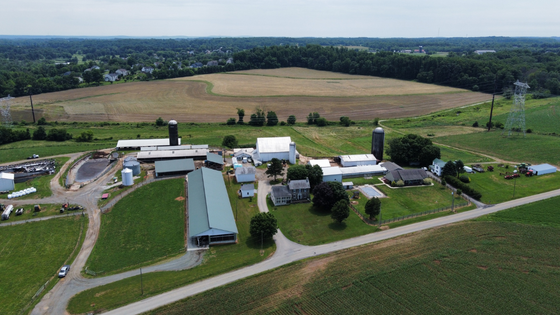There’s a new sheriff in town on one of Maryland’s oldest dairy farms.
Caleb and Alice Crothers were in their thirties when they left behind law enforcement and healthcare careers in Knoxville, Tennessee, to return to his family’s farm. Caleb took over the 200-cow herd at Long Green Farms in 2015, the year before his father passed away.
Long Green Farms is located in Rising Sun amid intense residential growth near the environmentally sensitive Chesapeake Bay. The Crothers don’t plan to grow their dairy herd’s size and are using conservation practices to make the farm economically and environmentally sustainable. “Conservation practices have a long history on Long Green Farms,” Caleb says. “Many of our neighbors are implementing several similar conservation practices to ensure the dairy industry continues to lead the way.”
The Crothers partnered with Appalachian Stream Restoration and Wetland Studies in 2020 to reconstruct and realign more than 14,200 feet of streambank of a creek that feeds into North East Creek, a direct tributary of the Chesapeake Bay. The project included planting 60,000 trees, grading, and installing many stream and fish habitat improvements. The project prevents 8,763 pounds of nitrogen, 1,210 pounds of phosphorus, and 1,974 pounds of sediment from entering the creek annually. “We’re grateful for our many partners that have contributed to our efforts,” Caleb adds.
To prevent soil erosion from farm fields, the Crothers plant 300 acres of cover crops to slow the velocity of rainfall and melting snow. Cover crops also improve the soil’s ability to infiltrate water, cycle nutrients, and build organic matter. An aerial applicator is used to broadcast cover crop seeds into standing crops of soybeans and corn, which gives the cover crop a jump start prior to the corn and soybean harvest. Long Green Farms also invested in a no-till planter for corn and soybeans to not disturb the soil’s structure.
To minimize the use of commercial fertilizers, the Crothers use drag lining to apply manure on their 225 acres of corn, 120 acres of soybeans, and 80 acres of hay. This process reduces field compaction and allows for precise application.
A livestock barn with manure storage was constructed in 2017 to provide a stable, non-eroding surface to house heifers. Clean rainwater from its roof, and runoff from terraces are diverted to grassed waterways that carry water to a safe discharge area without creating flooding or erosion. These areas, along with the land Caleb’s grandfather enrolled in the Conservation Reserve Program, improve water quality while providing wildlife habitat.
While Long Green Farms has lots of neighbors, it doesn’t generate complaints. Alice connects with neighbors and promotes ag literacy via her ‘Heels and Holsteins’ Facebook page. Caleb, an eighth-generation dairy farmer, serves on the National Dairy Research and Promotion Board. The Crothers have placed 535 of Long Green Farms’ acres into permanent protection with the Cecil Land Trust.
As for what’s next, the Crothers will soon replace an earthen lagoon with a concrete structure to store manure. With a goal of achieving carbon neutrality, they are exploring options to install a methane digester to generate electricity, and a sand separator to recycle sand used as livestock bedding. As farmers, they cite conserving the environment among their greatest callings.
The family farm has been around since 1759 and each generation has strived to make improvements. It’s clear Caleb and Alice are following that tradition. In 2022, the Crothers were recognized for their conservation efforts as recipients of the 2022 Maryland Leopold Conservation Award, which is awarded to farmers, ranchers and forestland owners in 24 states for their land, water and wildlife habitat management. “Winning the Leopold Award from Sand County Foundation is truly an honor and we appreciate the opportunity to highlight dairy’s contributions to environmental conservation,” Caleb says.
Hungry for more? Here’s another award-winning farm. Read about another farmer who left the medical field to become a chicken farmer. Watch this video to learn more about the Crothers family.
Sign up for our newsletter and find us on Facebook, Twitter and Instagram.


God Bless you for what you are doing. My father and mother were dairy farmers around Rising Sun, MD.
we need more farmers in the dairy field